Squash borers are one of the most frustrating pests for many vegetable gardeners, but it is possible to get rid of them and prevent them from destroying your plants.
In this post, I’ll show you several all-natural treatment methods to help you eliminate them, and I’ll also give you control tips to keep them from coming back.
You’ll learn all about their feeding habits, life cycle, where they come from, the damage they cause, and how to quickly spot the telltale signs of an infestation.
I’ve been growing squash in my garden for a few decades, so I know firsthand just how frustrating vine borers are to deal with. They are sneaky, and can go unnoticed for a very long time.
Since they bore into the vine, most people don’t even know there’s a problem until their plants suddenly wilt and begin to die.
Over the years, I’ve killed hundreds of these annoying little buggers. But I’m happy to say that I’ve successfully saved every one of my plants – and you can too by following my step by step process below!
What Are Squash Vine Borers?
Squash vine borers (also called “squash borers” or “squash worms”) are common pests of plants in the cucurbit (or squash) family, and they are very destructive. They’re the larvae of the squash borer bug, which is a type of moth.
They get their common name because they bore into the vines of the plant, eating them from the inside out. A trait that makes them impossible to see, and difficult to control.
You’ll only find them inside of the vine, stem, or the fruits. So if you have bugs crawling all over the outside of your plants and the leaves, those are squash bugs, and here’s how to get rid of them.
What Do They Look Like?
Squash borers look like white worms with a black head and wrinkly bodies. They start out tiny, and grow to be about one inch long.
The adults are a type of moth which, I hate to admit, is actually kinda pretty. The moths are reddish-orange with black wings and black dots down the length of their back. They’re active during the day, and look like a wasp when they fly.
Related Post: How To Control Garden Pests Naturally
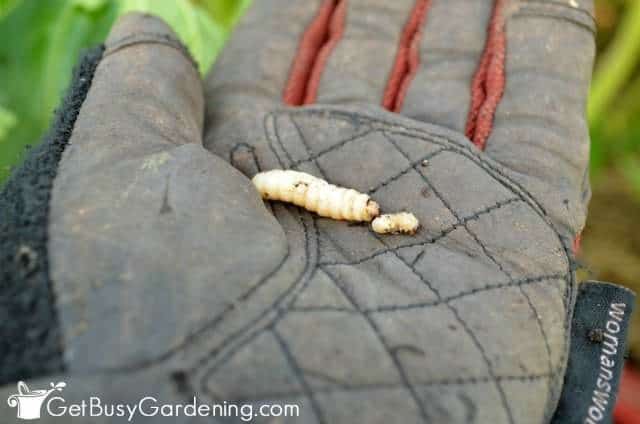
Life Cycle
There are four stages in the squash borer life cycle: eggs, larvae (borer), pupa, and adult (moth). The adults emerge in late spring or early summer, and the females will start laying eggs on nearby cucurbit plants shortly after.
They lay the eggs at the base of the plant, where they will hatch 1-2 weeks later. While they can lay a lot of eggs, the good news is that the moths are only active for about a month (usually June-July).
Shortly after the eggs hatch, the tiny squash borers will quickly burrow into the stem of the plant. As they feast they grow larger, reaching their full size of about 1″ long in 2-4 weeks.
Once they are full-sized, they will leave the vine and drop into the soil, where they’ll form a cocoon and pupate. They overwinter in the soil in 1″ long reddish-brown colored cocoons, and will hibernate until the following spring.
If you live in a cold climate like I do, there’s only one generation of squash borers per year. But in warmer climates, there can be two generations per year.
Related Post: How To Grow Summer Squash
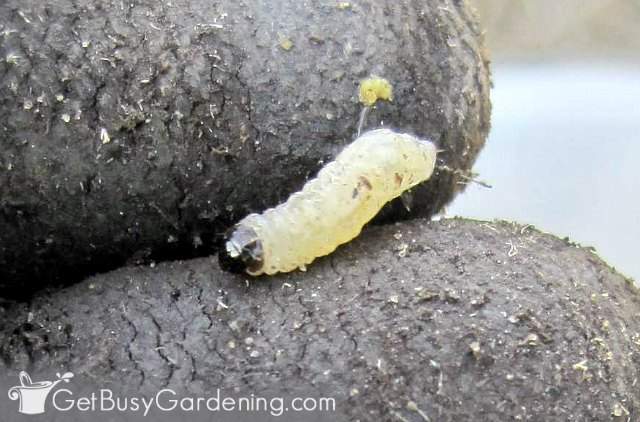
Where Do They Come From?
Since the adults can fly, squash borers could come from anywhere. They’re naturally attracted to cucurbits, since that’s their main host plant.
So, if the moths are present in your area of the world, and you’re growing any type of cucurbit plant, then it’s a sure bet they’ll find your garden.
What Do They Eat?
The main host plant for squash borer moths are vegetables in the Cucurbitaceae family. This includes all types of squash (both summer and winter), zucchini, pumpkins, and gourds, as well as melons, luffa, and cucumbers.
The borers do love squash plants the best though (hence their nickname). So, it’s much less common to find them feasting on cucumber and melon plants.
You’ll usually find squash borers eating the insides of the vines. But sometimes they will find their way into the fruits too, and destroy them from the inside out (Gross!).
The good news is that the larvae are the only stage in their life cycle where they eat plants. They are harmless in both their adult and pupa stages.
Related Post: How To Grow Winter Squash
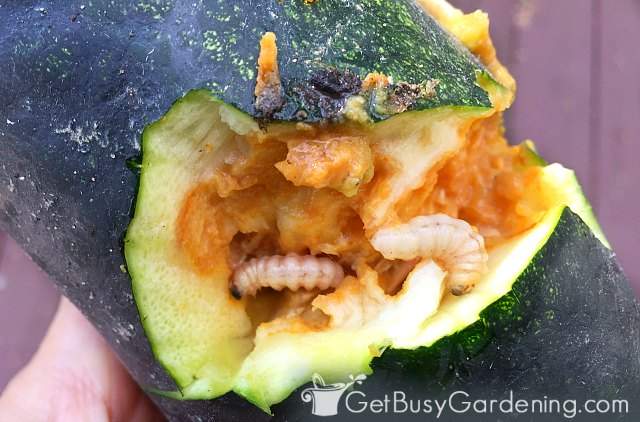
Damage To Plants
Since they eat the vines from the inside out, squash borer damage is difficult to spot unless you know what to look for.
If your squash plant has any of the symptoms below, then it’s time to take immediate action to get rid of the borers before they completely destroy the vine.
Here are the main signs to watch out for…
- Droopy leaves, or the entire plant suddenly wilts.
- Holes anywhere on the vine or stem.
- Mushy yellow sawdust coming out of the stem, vine, or fruits (this is their poop, also called frass).
- The vine is soft, split open, appears to be rotting, or is completely severed.
- Canker wounds or soft spots on the fruits.
- White worms inside your squash vines, stems, and/or the fruits.
Related Post: How To Grow Zucchini
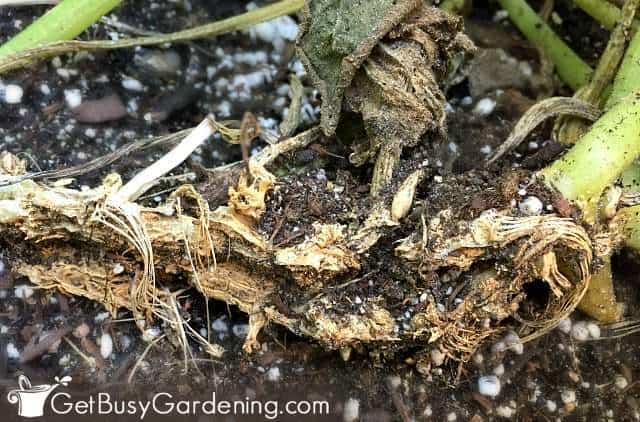
How To Get Rid Of Squash Vine Borers
Since they are inside the plant, pesticides (organic or otherwise) won’t work on them. But don’t worry, it’s pretty easy to get rid of squash borers organically by using a simple, non-toxic, and very effective method that I like to call… digging those nasty suckers out of the vine.
It takes a little bit of work, but it sounds harder than it is. And it really is the only way to get them out of the vine. Below I will walk you through how to do it step by step.
Supplies Needed
- Utility knife
- Bucket (optional)
- Liquid soap (optional)
- Water (optional)
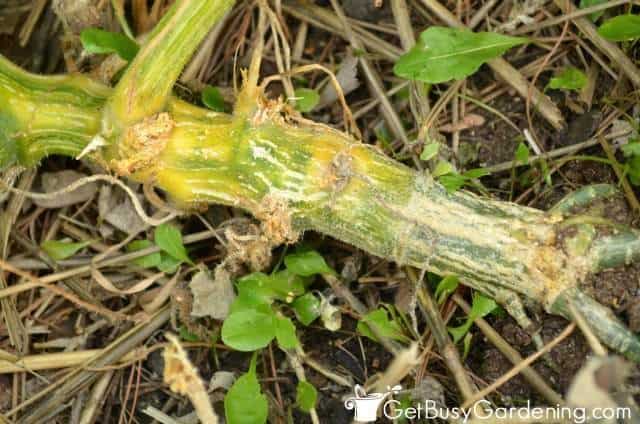
Step By Step Instructions
Step 1: Slice open the vine – Carefully slice open a small part of the vine just above the spot where you see the borer hole or sawdust mush.
Make a 1-2″ inch long cut the long way (i.e.: parallel to the vine) using a sharp utility knife. Take care not to sever the vine, you just need to open it up.
Step 2: Find the squash borer – Gently pry open the slit you made in the vine to look for the borer.
You may spot it right away, or you might need to make the cut a little larger so you can search around. It could be above or below the entry hole, but you’ll usually find them pretty close to the frass.
Step 3: Remove and kill it – Once you find a borer, pluck it out and kill it. You can simply squash it (pun intended!). Or, if that makes you too squeamish, then drop it into a bucket of soapy water.
Sometimes it’s easier to just squish it inside of the vine than it is to remove it. That’s fine, squash borer guts won’t harm your plant.
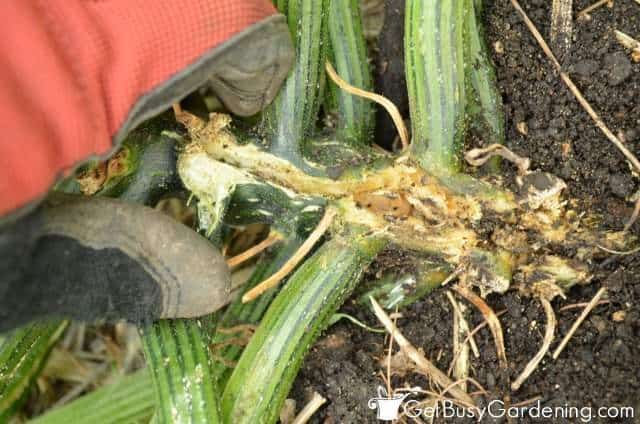
Step 4: Look for more squash borers – Continue inspecting the vine to look for signs of additional borers, and repeat steps 1-3 for each one that you find. There can be several of them inside of each vine.
Step 5: Bury the vine – Once you’re sure you’ve removed all of the borers, bury the injured section(s) of the vine with soil. Squash vines will form new roots under the soil, and the plant will become even stronger because of it.
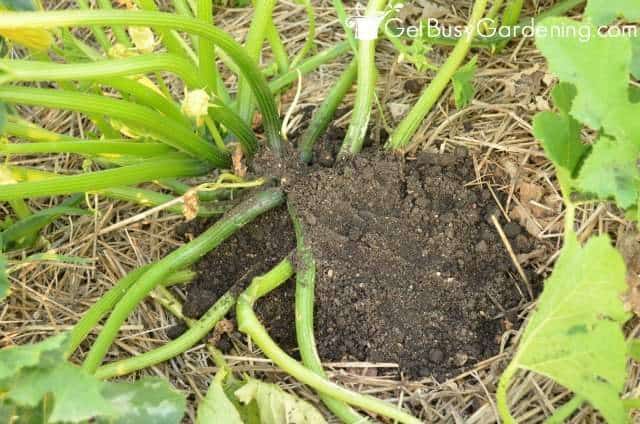
Additional Tips & Notes
Digging the borers out is the best way to get rid of them once they’re inside of the vine. And it’s so satisfying when you find them.
But sometimes you’ll see signs that there’s one inside the vine, and you can’t find anything after you cut it open.
Remember that the borers can be different sizes, and the smaller ones are much harder to spot than the big fat ones.
So don’t be discouraged. Maybe it was so small that you squished it without seeing it. Or maybe it was already fully mature and has left the vine. Just cover the injured part of the stem, and move on.
How To Prevent Squash Borers
There are lots of things you can do to prevent squash borers from infesting your plants in the first place. Use a combination of the techniques below to control their population, or even get rid of them all together.
Destroy The Eggs
Squash borer eggs are tiny, but they’re fairly easy to spot when you’re looking for them. The eggs are flat, oval shaped, and brown in color.
You’ll usually find them at the base of the stem of young plants, either at or near the soil line. But they can be anywhere on the vines of mature plants. There could be just one egg, or a few in a small cluster.
You can simply scrape the eggs off into a bucket of soapy water, or wash the vines with organic insecticidal soap to kill them. Be sure to inspect your plants regularly, and remove any new eggs before they hatch.
Related Post: Natural Garden Pest Control Remedies & Recipes
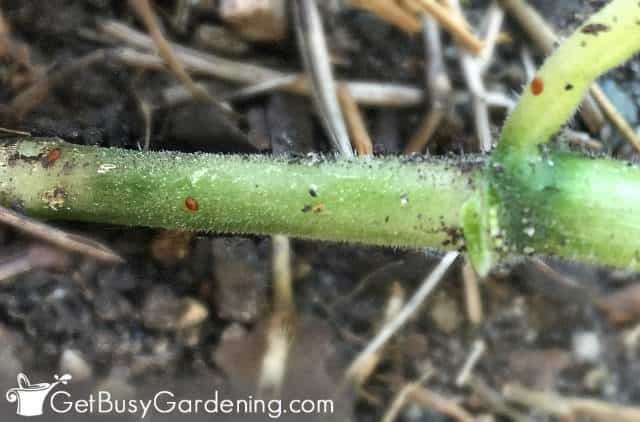
Try Sticky Traps
The adult squash borer moth is attracted to the color yellow. So, try placing sticky traps near your plants to trap them before they can lay their eggs.
These types of traps are completely non-toxic and safe to use in the veggie garden. They can also capture other pest insects too, which is a double bonus.
Use Aluminum Foil
Another great way to prevent squash borers is to wrap the stems of your plants in aluminum foil. This will confuse the moth, and prevent her from laying eggs. Here are the steps…
- Carefully dig down into the soil about 1/4″ inch around the base of the plant.
- Cut a small strip of aluminum foil, and wrap it around the entire stem of each plant.
- Push the soil back around the base of the stem, covering the bottom edge of the foil.
- Check the aluminum foil regularly, and re-wrap it if necessary.
Install Row Covers
Covering young squash plants helps to keep the borer moth from getting to the vines. You can buy row covers, or make your own out of inexpensive tulle fabric.
Keep in mind that this will also prevent pollinators from reaching your plants. So you should either hand pollinate your squash, or remove the row covers once the flowers start to open.
Destroy The Pupae In The Soil
As I already mentioned, squash borers overwinter in their pupa stage, and they hibernate in the soil. So, here are a few things you can do to get rid of them…
- Remove and destroy all of your cucurbit plants in the fall – especially any that have vine borer damage. Be sure to burn them or throw them into the trash, rather than putting them in your home compost bin. Otherwise, the pupa could just overwinter in there.
- Till or turn the soil in the fall and/or early spring to destroy the cocoons, or expose them to hungry predators.
Plant Trap Crops
Technically there is no such thing as a “squash borer-resistant plant”. Unfortunately, all types of cucurbits are susceptible to an infestation.
However, that being said, there are certain varieties that they prefer over others. They tend to really love zucchini (yellow and green) and hubbard squash the best.
Some gardeners use those varieties as trap crops to protect the less susceptible ones. A few of the borer’s least favorite varieties are butternut, tromboncino, and crookneck squash, as well as cucumbers and melons.
Related Post: How To Grow Cucumbers
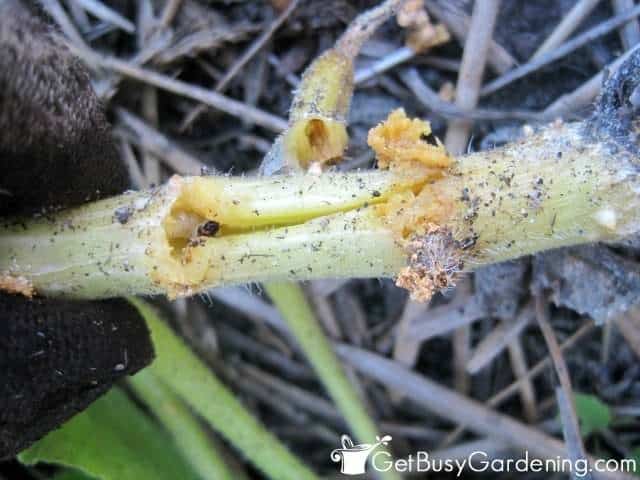
FAQs
While neem oil could kill the baby squash borers as they eat through the vine, it won’t work once they are inside the plant. If you want to try it, start applying it as soon as you plant your seedlings, and continue every few weeks until the moths are no longer active.
Diatomaceous earth can work to kill the adult moths and the larvae, but it won’t work once the squash borers are protected inside of the vine.
You can find squash vine borers inside of the stems, vines, or even the fruits of any type of cucurbit plant, including summer and winter squash, pumpkins, cucumbers, melons, and gourds.
Getting rid of squash vine borers can take some work, but it’s worth it to save your plants. Once you know the steps to take to control them, you can easily prevent them from ruining your crops.
If you’d like to learn how to make the most of your space and get as much homegrown food as possible, then my Vertical Vegetables book is perfect! It will teach you all you need to know, has tons of gorgeous photos, and includes 23 DIY projects you can build for your own garden. Order your copy today!
Learn more about my Vertical Vegetables book here.
Share your method for getting rid of squash vine borers in your garden, or your best prevention tips, in the comments below.
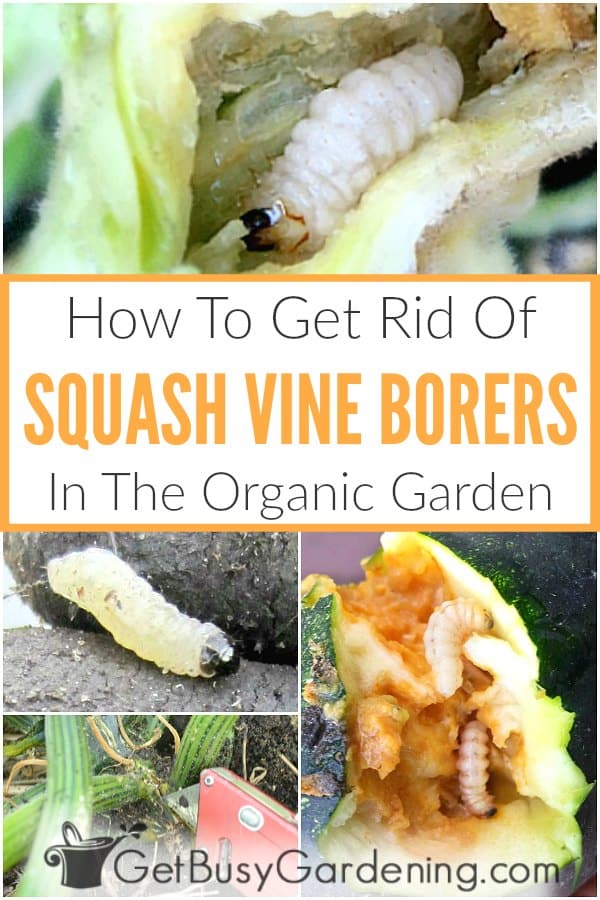
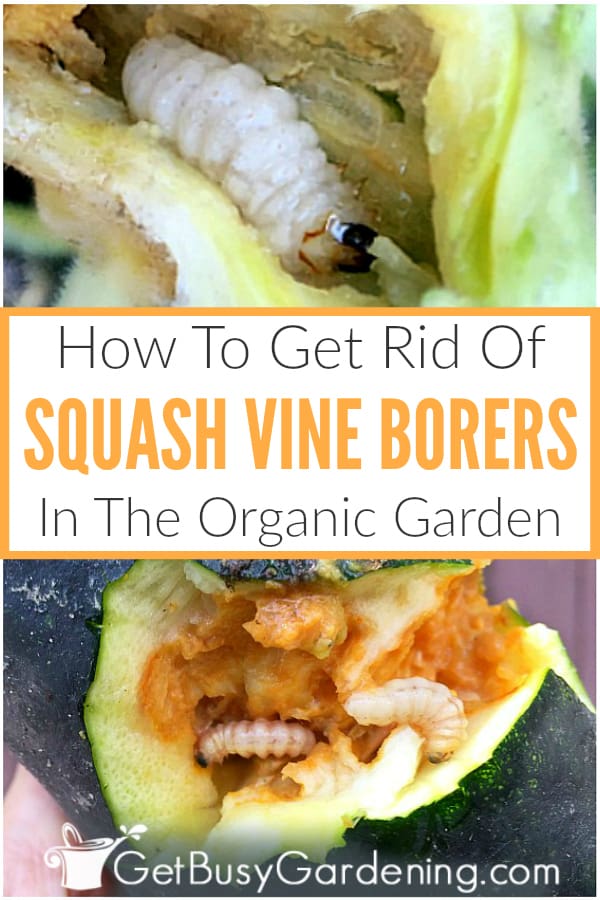
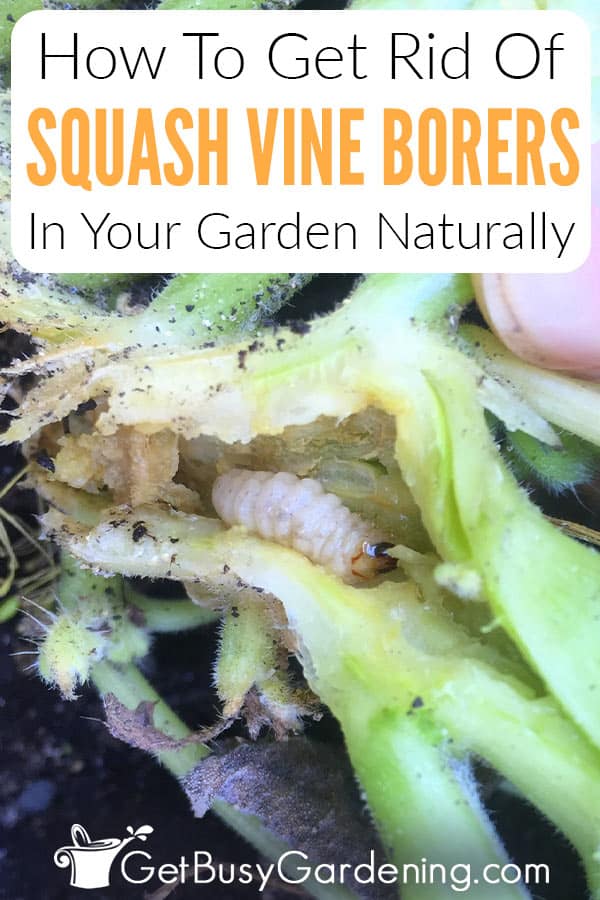

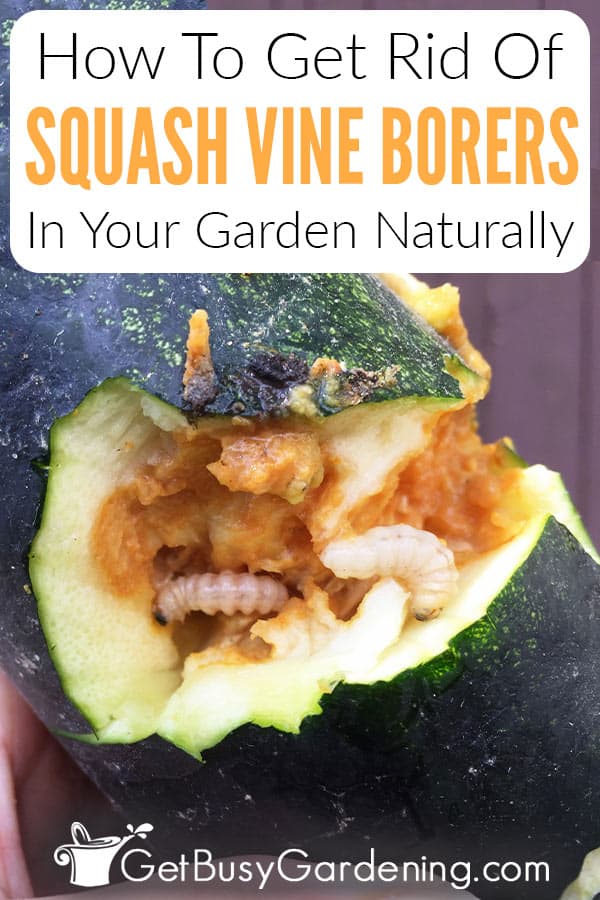
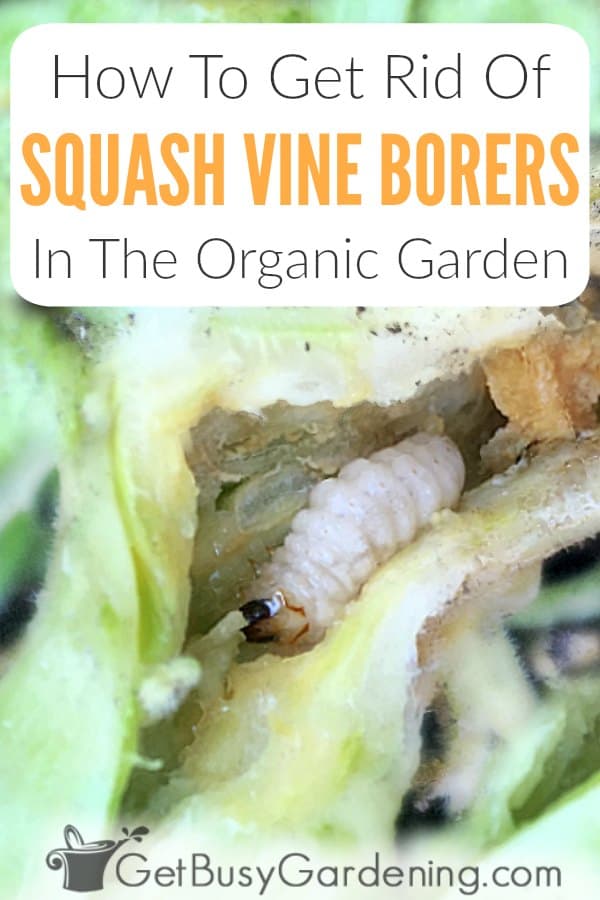
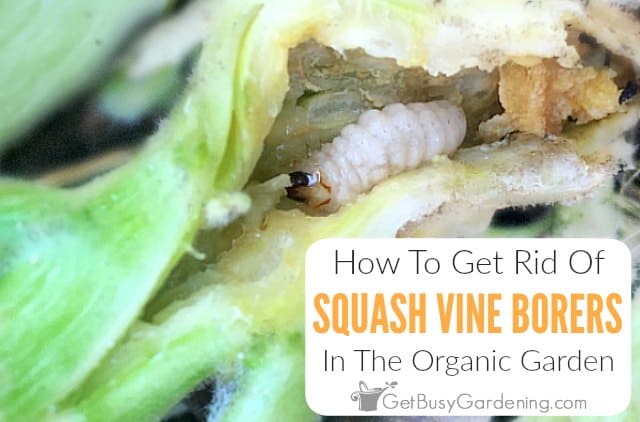

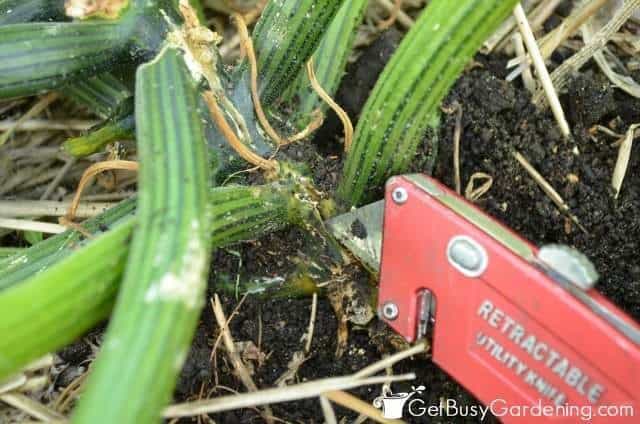


Laura Harrison says
For what it’s worth I inject BT in the stem with a needle and it did kill the borers. You have to inject further up from the frassy area and let them come to the BT. No rebury required b/c you are only leaving a small hole in the stem of the plant.
Amy Andrychowicz says
Awesome, thanks for sharing your experience, glad to know that injecting BT into your squash stems worked to kill the borers!
David says
What is BT?
Amy Andrychowicz says
BT stands for Bacillus Thuringiensis. It’s a natural beneficial bacteria found in the soil that kills many types of bugs and their larvae, including squash vine borers. It’s very commonly used as a natural pest control method for organic gardeners.
Ria M. Riesner says
Laura Harrison – I do the same with injecting BT into the stems of squash plants affected by the borers. This year SVB’s destroyed 1 pumpkin plant, and attacked a couple of my zucchini plants. I seem to have caught the Zucchini SVB’s in time – I removed the borers and I inject the zucchini stems 1X week with BT. Those plants are producting new flowers and fruit, so Im hopeful! What I’m wondering is, is there an easy way to kill lingering squash vine borer eggs in potting soil? I am in particular curious if any more experienced vegetable gardeners know if pouring boiling water on potting soil used (where a squash plant affected by SVB was growing) I have multiple 20 -30 gallon containers where I am growing squash plants and I’m hoping to find a way to kill the SVB eggs (without tossing the Fox Farms Organic Ocean Forest potting soil that my squash are growing in) My squash vines seem to love that potting soil (they just get chewed up like crazy with SVB’s. I’ve put tin foil around all of the stalks of my zuchinni, cucumber, yellow crookneck squash and pumpkin plants.
Amy Andrychowicz says
Squash vine borer eggs don’t live in the soil, the adult females lay their eggs on the base of the stem of the plant. However, the borers themselves drop into the soil to pupate, and can overwinter in there. I have never tried boiling water, but I grow mine in the garden and not in pots. Turning the soil in the fall helps to expose the pupa so that birds can eat them, or they freeze when exposed to freezing cold, but it’s not going to get rid of all of them. Also, even if you could completely rid your soil of the pupa, squash borer bugs can fly, so they can still infest your plants from anywhere. But it certainly wouldn’t hurt to turn the soil once freezing temps come to your area, which could expose/kill some of them.
Taylor says
What are your thoughts on injecting stems with Bt?
Amy Andrychowicz says
I have never tried it myself, but I’ve had other readers say that they’ve had good luck using BT (Bacillus Thuringiensis) to get rid of squash borers.
David says
I have seen but only one squash bug this year as opposed to hundreds in past years.
This year I’ve used garden safe organic Neem spray. Furthermore, my original zucchini plant 🌱 is still thriving, so no beetle 🪲 bugs have destroyed it!
Amy Andrychowicz says
Yay, this is great news!! So happy to hear you’ve been able to get rid of most of the squash vine borers in your garden!
R Smith says
Is there anything that can be done this fall to kill off any leftover borers? I have 1/2 acre 3rd generation garden in Northeast Georgia. Good soil. Very nice looking garden until squash collapses. Crook neck, straight neck is my primary squash. Should I light harrow up a couple of times in a week or two prior to winter to expose them? I plant rye grass for cover over winter, so I need to have some timeline. These borers are becoming a bad habit. I rotate vegetables every year. Thanks
Amy Andrychowicz says
Yes, you can turn the soil to kill and expose squash bugs and pupae in the soil, that will definitely help. I would also recommend spraying beneficial nematodes over your plot. They feed on soil-dwelling pests and are completely harmless to humans and animals.
Phil Marasco says
Great Article! I just went out & saw that they got me again.I had them years ago. Stopped planting squash for a few years. Haven’t had them for a few years Until Now! One of the plants, which looked good on the top, completely detached from the bottom. I tried “Taping” it together but couldn’t. It was high enough above the soil so it didn’t show any potential Root growth. .What do you suggest?
Amy Andrychowicz says
Ugh, sorry to hear the squash borers found your garden again. The only way to save the vines that are completely severed is to bury them in damp soil so they can root again. If that’s not possible, then I don’t think you’ll be able to save them. 🙁
Phil says
Thank You for your Quick Response. Wish it was better news, but i Really Wasn’t expecting it could be saved.
Amy Andrychowicz says
You’re welcome.
Rachel says
Thank you so much for the advice–I am growing cucumbers this year and watching them like a hawk. I think I may see some wilting in the mid-day, so I’m starting to inspect the stems, and other websites (including university extensions) have said there’s no hope once the borers are in. SVB destroyed all my zucchini last year and my borage, too. This year I just didn’t start any cucurbits until late July. I bought seeds from Baker Creek for the Seminole squash, a wild variety that purportedly is resistant to SVB because it doesn’t have a hollow stem–might be worth looking into. I’m giving it a try this year in my 7A garden and so far it looks good, and the silver-veined leaves are beautiful, too.
Amy Andrychowicz says
Every year my squash plants become infested with vine borers, and every year I dig them out and save my plants using the steps I detailed in this article. Heck, I’ve even saved ones where the vines were completely severed by the borers. So, it is doable FOR SURE! I have no idea why others are saying there’s no hope once they’re infested, I’ve been doing this for many years with great success. I guess it would be true if you didn’t do anything, and left the borers alone to destroy the plants. Digging them out is a pain for sure, but works, so don’t give up. Hopefully planting them late works for you though, that’s a great strategy! We can’t do that in zone 4, unfortunately, or there wouldn’t be enough time for the plants to mature before frost. 🙂 Oh, and p.s., I’ve never had them attack my cucumbers, so fingers crossed yours will be fine.
Julie says
What months are they active?
Amy Andrychowicz says
The adult female squash borer moths are only active for about a month, usually about June-July. But the larvae can persist all the through fall/frost.
Dianne says
Amy, thank you. I have been operating and fighting these things for 5 years. Each year looking up more advise, moving crops around, yellow bowls this year and ready to put diatom on today. Your article was the most comprehensive to date. Showing excellent photos of the creatures life cycle, flying, eggs, timing, cutting out and replanting the infected plant. I’m in N.H. and appreciate the full monty for getting rid of these monsters. Heading down now to find some eggs to kill. Very, very good article.
Amy Andrychowicz says
Thanks so much for you nice comment, I’m happy to hear you found my article the most comprehensive of all the ones you’ve read. 🙂 You’re welcome, and good luck getting rid of your squash borers!
Katy says
Well I sliced and operated to remove the borers that I could find. Hope it’s all of them! Darn things! I did bury the operated on parts but feel I mangled the plant; do you think they have a good chance of survival?
Amy Andrychowicz says
I completely severed a vine one time digging out the borers, and my squash plant survived it. Just make sure to keep the soil evenly moist, and they should grow new roots from the buried part of the stem.
Rhonda L. says
I am wondering if Neem oil could be injected into the stem to kill the vine borer?
Amy Andrychowicz says
I have never tried injecting anything into the stem to kill the squash vine borers, so I can’t speak from experience on that. Keep in mind that neem oil doesn’t always kill them on contact, it can take some time. So, you might want to try something else to kill them faster. I’ve had readers tell me they’ve had success with soapy water or peroxide. But again, I’ve never tried those myself (I’ll have to do some experimenting this year!), they must come in direct contact with the borers to kill them, and it can be difficult to know exactly where they are inside the stem. It would be a good experiment though, if you’re up to trying it. 🙂 Good luck!
Nancy Webb says
I am going to try Hubbard squash planted around the garden. It is supposed to be a trap crop for borers,
Amy Andrychowicz says
Oh interesting. I’ve never heard of one type being more attractive to squash borers than others, but worth a try. Make sure to continue to check all of your plants just in case.
David Sidebottom says
My friend uses hydrogen peroxide. 2 tbs per one gallon of water. But once they are inside, it’s too late to spray
Amy Andrychowicz says
I have heard of people injecting it into the vine too, to kill the borers inside. I have never tried this myself, so can’t speak from experience though.
rfannie says
I have had problems with borers in the past with my zucchini.. My daughter went to camp and we sprayed Coleman Gear and Clothing Insect Repellent 6 oz spay on her clothes to combat ticks… it worked perfectly.. so why not zucchini.. I sprayed the vine stems in june every 2 weeks after dark to not disturb bees.. not a single plant has any borers.. my only problem now is too many zucchini.. neighbors won’t open their doors anymore..lol
Amy Andrychowicz says
Great to hear that you were able to keep the squash vine borers from infesting your zucchini. Just keep in mind that the product you describe is not an organic option. Having too much zucchini is a good problem to have. LOL!
Jasper says
I have several squashes in containers and I had a plant totally wilted watered it then thought it was dead, as I started to cull it I felt a mushy spot on stem, I am growing upright with cages. That’s when I discovered the monster, cut it up, then I checked the others and each had two holes in their stems. I jumped into bug war mode and got several Q Tips and my melaluca product Sol-U-Guard, first I sprayed the hole good, then the qtip and worked it in to the hole smashing the monster and sprayed some more. I said some prayers for the plants and half expected them to be down this morning but they were up and looking strong. I also sprayed the vines up and down.
Amy Andrychowicz says
Wonderful, so glad to hear you were able to save your squash plant from the borers. They are nasty creatures, aren’t they!?! Yuck! I’ve never heard of the product you mention, sounds interesting. Does it work to kill bugs?
Gary Cramer says
Just came in from the garden. Noticed a little frass yesterday so I mixed up some BT (bacillus thiriengensis) grabbed a hypodermic needle (you can get them at Tractor Supply and various places on-line) and injected the solution on both sides of the borer entry hole. One bite of this naturally occurring organic bacteria causes the larvae to stop eating and it just dies inside the vine. It is easier to inject the solution if you make a hole in the vine with a blade first, so the needle doesn’t get clogged up.
Amy Andrychowicz says
Awesome, thanks for sharing your tip about how you get rid of squash borers. I have never tried this method, so I will definitely have to try it sometime.
Susan says
Thanks. I have so many squash plants in a small area that it might be hard to find them by sticking a pin in the vine. If there is another way, I’d like to hear it. Thanks.
Amy Andrychowicz says
The only way you can get the borers out of your squash vines is to find them and dig them out, as I demonstrated in the article above. However, if you don’t want to do that, you can bury the section(s) of the vine above the borer. That way, the vine will grow new roots, and survive even if the bottom part has been completely severed by the borer. Good luck!
Nicole Thompson says
Neem oil doesn’t harm bees. http://npic.orst.edu/factsheets/neemgen.html#wildlife
Mike says
Exactly. No reason not to use neem.
Nancy says
I read that planting radishes around squash would deter squash vine borers. Has any one tried it?
Amy Andrychowicz says
I haven’t heard of that combination before. I do know that nasturtium is said to deter squash borers though, so try that.